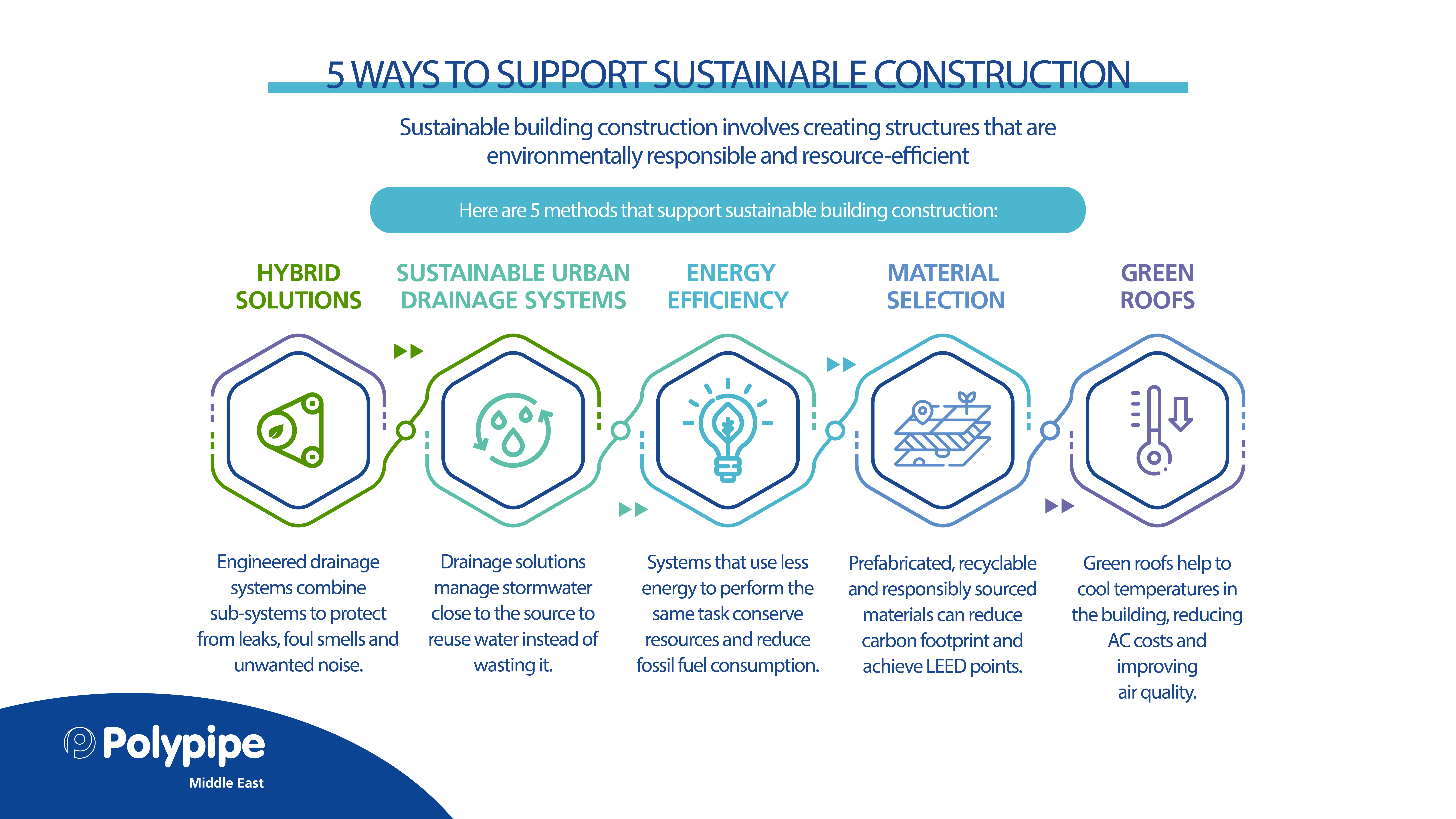Permavoid Shallow Geocellular Water Management System
Permavoid is our award-winning water management solution, designed to provide shallow water storage for attenuation, detention or soakaway/inf

As the sustainability story unfolds on a global scale, we see the evolution of many industries moving towards the integration greener practices across the supply chain – from manufacturing to operations.
In the construction industry, companies are increasingly finding ways to reduce their environmental impact across the supply chain. This is known as sustainable building construction. It focuses on creating structures that are environmentally responsible and resource efficient.
We can see this trend growing through the rising number of green buildings around the world. For example, in the UAE, there are currently 386 LEED certified projects.[i] The global green buildings market will continue to flourish, expected to grow at a healthy rate of 14.3% CAGR by 2027.[ii]
However, sustainable building construction doesn’t just involve creating more resource-efficient buildings. It’s also about developing eco-friendly infrastructure that supports the wider community. It’s about creating safe, comfortable and sustainable spaces that contribute to the creation of greener cities.
Sustainable building construction tends to integrate a value engineering approach. Value engineering is essentially the practice of reducing costs while improving performance of systems in a building. This approach usually points towards resource efficiency, resulting in higher performing systems that lower in costs. Learn more about value engineering.
The result of adopting sustainable building construction practices is a high performing building that uses resources wisely, helping to maximize ROI on your project.
Here are 5 ways to integrate sustainable building construction practices into your next project:
1) Hybrid Solutions
Our buildings are diverse ecosystems – they are made up of many subsystems, from lighting to HVAC, that come together to create a well-functioning overall structure. Essentially, our buildings are a hybrid of diverse systems. Selecting strong, engineered solutions – each created specifically for the task at hand – helps to create a safer and more sustainable building. Hybrid drainage solutions, for example, can help protect against leaks, foul smells and unwanted noises – to maintain healthy air quality. Clean air is a key element of keeping all kinds of organisms on our planet safe.
2) Sustainable urban Drainage Systems (SuDS)
SuDS are a collection of water management practices that aim to align with natural water processes. What could be more sustainable than mimicking nature itself? Essentially, these systems capture rainwater close to source and let it infiltrate back into the earth, reusing water instead of treating it as a waste product. SuDS helps to reduce flood risk, a common challenge in the region, in addition to supporting the creation of greener environments that deliver a number of social benefits. Solutions like our water management system, Polystorm, support SuDS, helping to reduce flood risk.
3) Energy Efficiency
Building currently uses about 40% of the global energy and emit approximately 1/3 of global greenhouse gas emissions.[i] Employing more energy efficient systems, particularly for HVAC purposes, can help to significantly reduce energy demands and related costs. Reducing energy demands lowers the building’s consumption of fossil fuels and consequently, it’s greenhouse gas emissions. In the Middle East, AC demands are high due to the hot climate. Investing in smart systems is one way to improve energy efficiency. Systems that adjust automatically to consume energy on a need-only basis can result in significant energy savings in the long run.
4) Material Selection
Selecting more sustainable materials is a key element of creating greener buildings. Choosing recyclable and responsibly sourced materials can significantly help to lower a building’s carbon footprint. Furthermore, prefabricating systems in a controlled environment, we can reduce waste, transportation use and labour costs.
5) Blue/Green Roofs
The creation of blue/green roofs is growing increasingly popular on a global scale. The practice of converting unused building roofs into green havens can deliver a number of benefits. Blue/green roofs integrate SuDS water management which helps to manage resources and stormwater much more effectively. They also help to cool building temperatures, reducing AC demands by up to 75%. Finally, they provide green, multi-functional spaces amidst concrete cities, supporting human health and wellbeing. Read more about blue/green roofs. Our multi award-winning shallow water management solution, Permavoid, can be used to capture, store, treat and reuse water for blue/green roofs and passive on-demand tree planter irrigation.
Learn more:

The connection between people and our planet has always existed, but it has increasingly come into focus in recent years. Supporting sustainability is now commonly considered a core principle for modern human life. Supporting sustainability not only protects our ecosystems but it also preserves natural resources for future generations. It not only directly improves quality of life, but it also gives businesses the chance to improve productivity, reduce costs, enhance brand image and deliver a true competitive advantage.
At Polypipe Middle East, we deliver drainage and water management solutions that support sustainable construction. Contact us to find out more for your next project.
Tel: +971 (0) 4 518 3000
Email: middleeast@polypipe.com
Permavoid is our award-winning water management solution, designed to provide shallow water storage for attenuation, detention or soakaway/inf
Polystorm is an efficient and versatile geocellular water management system for Sustainable urban Drainage Systems (SuDS) compliant attenuation, det